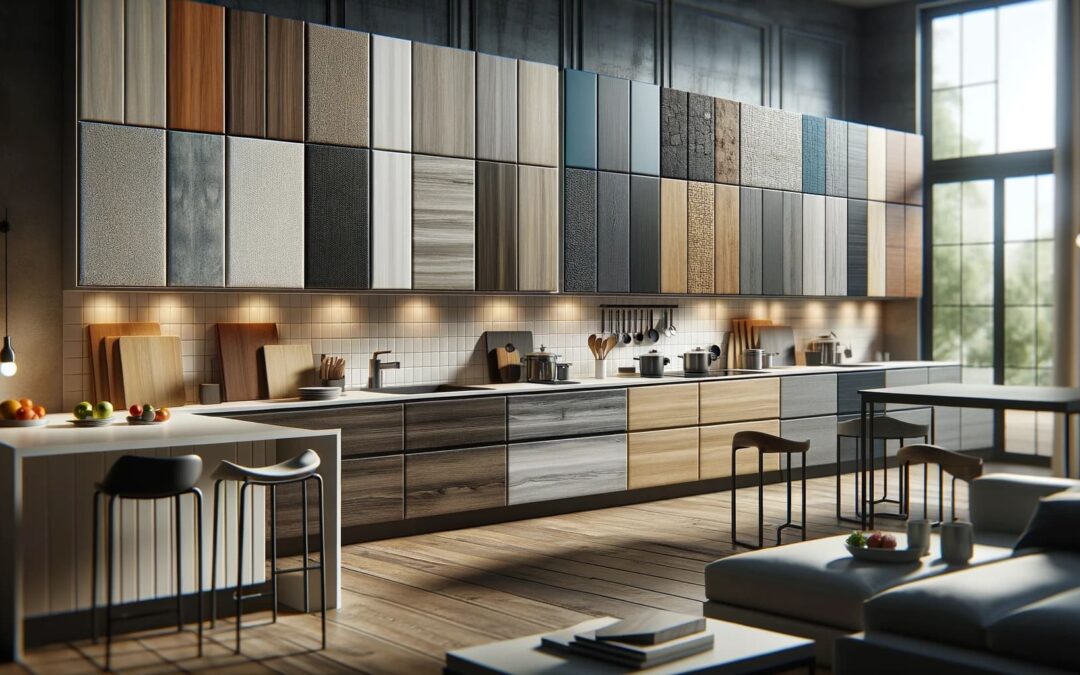Choosing the right texture for kitchen cabinets is a critical decision that affects both the aesthetics and functionality of your kitchen. Different textures, from sleek and smooth to rugged and rustic, can significantly alter the ambiance of your kitchen space. This article explores the pros and cons of various popular kitchen cabinet textures to help you make a more informed choice.
1. Glossy Finish
Pros:
- Reflective Beauty: Glossy cabinets reflect light, making your kitchen appear brighter and larger. This is particularly beneficial in smaller or darker spaces.
- Modern Appeal: A glossy finish has a sleek, modern look that pairs well with contemporary kitchen designs.
- Ease of Cleaning: Smooth glossy surfaces are easy to wipe down, making them practical for kitchens where hygiene is a priority.
Cons:
- Visibility of Fingerprints and Smudges: Glossy surfaces tend to show fingerprints, watermarks, and smudges more readily than matte surfaces.
- Scratches are More Noticeable: Over time, scratches can become more evident on glossy surfaces, which may require more careful handling.
2. Matte Finish
Pros:
- Subtle Elegance: Matte cabinets offer a soft, elegant appearance that can make your kitchen feel warm and welcoming.
- Hides Smudges and Fingerprints: Unlike glossy finishes, matte textures do not show smudges and fingerprints as easily, which can keep your cabinets looking cleaner.
- Versatility in Style: Matte finishes blend well with various design styles, from modern to traditional.
Cons:
- Can Show Dirt and Stains: While smudges are less visible, matte surfaces can show dirt and stains more than their glossy counterparts, which may require frequent cleaning.
- Lack of Shine: For those who prefer a sparkling kitchen, matte finishes do not reflect light, which can make the space feel less vibrant.
3. Wood Grain
Pros:
- Natural Aesthetic: Wood grain textures bring a touch of nature into your kitchen, offering a warm, organic feel that is often associated with traditional and country-style kitchens.
- Unique Variations: Each piece of wood has unique markings, meaning your kitchen cabinets will have a distinct look with natural variations in texture.
- Durability: Properly sealed wood can be very durable and withstand the rigors of kitchen use.
Cons:
- Maintenance: Wood cabinets may require more maintenance than other finishes, including occasional resealing to prevent moisture damage.
- Susceptible to Humidity: Wood can warp or expand in highly humid conditions, which might affect the longevity and appearance of your cabinets.
4. Textured Laminates
Pros:
- Highly Durable: Textured laminates are manufactured to be durable and are resistant to scratches, moisture, and heat.
- Variety of Options: Available in a range of patterns and designs, textured laminates can mimic more expensive materials like wood or stone at a fraction of the cost.
- Low Maintenance: These surfaces are easy to clean and require minimal upkeep compared to natural materials.
Cons:
- Less Premium Feel: While technology has improved the look of laminates, they can sometimes lack the depth and premium feel of natural materials.
- Damage is Difficult to Repair: If laminates are damaged, they can be difficult to repair, and often the only option is replacement.
Conclusion
When selecting kitchen cabinet textures, consider not only the style you wish to achieve but also the practical aspects of kitchen use. Each texture has its advantages and drawbacks, and the right choice depends on your aesthetic preferences. Lifestyle, and how much maintenance you are willing to undertake. By weighing these factors, you can choose a cabinet texture that enhances both the beauty and functionality of your kitchen.

